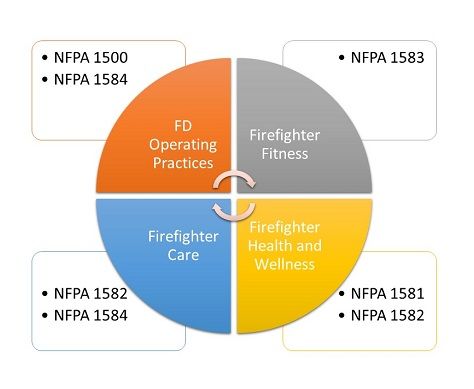Health and wellness programs for firefighters have been a fire service hot topic for many decades. For much of our history, fitness was an afterthought or only a concern for a few individual firefighters, or perhaps isolated to a station’s habits and culture. It wasn’t until about 30 years ago that the fire service, with representatives from labor and management, took a comprehensive approach to firefighter health and wellness. Standards have developed to codify evolving practices and push improvement.
Firefighter health and wellness programs also have the support and backing of organizations like the National Fallen Firefighters Foundation and the National Volunteer Fire Council. The movement continues to gain momentum as we learn more about the physical and psychological threats posed by the job, such as increased risk of developing cancer and the effects of post-traumatic stress. Here’s how health and wellness programs for fire departments have evolved.
NFPA standards are a driving force for systemic health and wellness programs
Because NFPA standards are consensus standards, they typically serve to codify change that’s taken place in the fire service or that’s actively taking place. NFPA standards are also revised on a five-year schedule so that they keep pace with change in the fire service. In the case of health and wellness programs, there are now several pertinent standards, each of which addresses a component of a total health and wellness program.
“NFPA 1500: Standard on Fire Department Occupational Safety and Health Program” is the forerunner to the other NFPA standards that have a stake in firefighter health and wellness. By defining what safe, effective and efficient operating practices should be for a fire department, NFPA 1500 helped identify specific areas that needed additional standards.
“NFPA 1581: Standard on Fire Department Infection Control Program” and “NFPA 1582: Standard on Comprehensive Occupational Medical Program for Fire Departments” are two standards spawned by the publication of NFPA 1500. I believe that those three standards – 1500, 1581 and 1582 – created a heightened sense of awareness for the connection between firefighter occupational health and firefighter fitness.
That increased awareness prompted the development of “NFPA 1583: Standard on Health-Related Fitness Programs for Fire Department Members,” which defined the minimum requirements for the development, implementation and overall management of a fire department’s fitness program.
NFPA 1583 is a resource for firefighters that can help them make the linkage between effort – what they’re doing to improve their physical conditioning – and results – an increased capability to carry out the physical tasks of their job safely, effectively and efficiently.
For fire chiefs, and those charged with managing a department’s fitness program, NFPA 1583 provided an industry-based standard for them to use in understanding what a firefighter fitness program should look like and address, including:
1. Member roles and responsibilities;
2. Qualifications for health and fitness coordinators and peer fitness trainers;
3. Guidelines for periodic fitness assessment;
4. Fitness training program components;
5. Health program promotion and education requirements; and
6. Requirements for data collection.
The standard also includes tools, such as a sample fitness plan and a sample self-assessment worksheet, to aid in implementing a fitness program on the department level.
The final link in the chain of health and wellness standards is “NFPA 1584: Standard on the Rehabilitation Process for Members During Emergency Operations and Training Exercises.” The development of this standard completed the chain – a continuous loop – for firefighter health and wellness. See Figure 1:

Figure 1: A comprehensive firefighter health and wellness program should address all activities that contribute to maintaining a firefighter’s ability to function in the job. (Figure/Robert Avsec)
Fire service Wellness Fitness Initiative
In the latter part of the 1990s, the International Association of Fire Fighters and the International Association of Fire Chiefs collaborated in an unprecedented endeavor involving labor and management to address firefighter health and wellness. The work of this task force took place in three phases.
In the first phase, they created a network of selected geographically diverse fire departments that had a history of excellent union and management relations. Each of those selected fire departments was represented by the fire chief and the IAFF local union president. Additionally, invitations were extended for each department to have a physician, physiologist or fitness coordinator participate as well. In this phase, each department committed to making a concerted effort toward success of the project.
The next phase consisted of data collection from the participating fire departments and analysis of that data to create a valid set of baseline data that would be suitable for comparison across the fire service in the U.S. and Canada.
In the final phase, the task force used that data to create a comprehensive program for dissemination across the fire service. The result was the Fire Service Joint Labor Management Wellness-Fitness Initiative, which was commonly referred to as the Wellness Fitness Initiative or WFI. An excerpt from the WFI mission statement:
“Any program of physical fitness must be positive and not punitive in design; require mandatory participation by all uniformed personnel in the department once implemented; allow for age, gender and position in the department; allow for on-duty-time participation utilizing facilities provided or arranged by the department; provide for rehabilitation and remedial support for those in need; contain training and education components, and be reasonable and equitable to all participants.
The WFI was introduced to the fire service in August 1997 at the IAFF’s Redmond Safety Symposium, as well as the IAFC’s Fire Rescue International conference. The WFI represented the combined efforts of both organizations to build a safer, more effective and more efficient fire service through a program to strengthen the health and wellness of the individual firefighter.
Wellness Fitness Initiative spin-offs
In addition to the WFI, the IAFF and IAFC task force has created several supporting programs:
1. The Candidate Physical Ability Test (CPAT)
2. The Fire Service Peer Fitness Trainer Certification
3. The WFI Resource
While many in the fire service are familiar with CPAT and the Peer Fitness Trainer programs, the WFI Resource may not be as well known.
A number of fire departments throughout the United States and Canada have developed model wellness-fitness programs based on the Wellness-Fitness Initiative. This WFI Resource is an opportunity for your local and fire department to learn from these successful programs to develop or enhance your own wellness-fitness program.
The WFI Resource is a centralized source of information about successful firefighter health and wellness programs. In addition to the health and wellness programs from the 10 fire departments that formed the task force cohort, 13 additional fire department programs are currently listed on the WFI Resource.
This online resource guide can be a valuable tool for new health and wellness program managers who can benefit from the experience of others. WFI Resource, which is continually updated and expanded, includes additional online resources for those new and incumbent fitness program managers to gather information on successful programs, contact those who are managing those programs and benefit from the experiences of others.
Firefighter life safety
Additional energy, building off efforts from a decade earlier, has come from sources like the National Fallen Firefighters Foundation. In March 2004, the NFFF hosted a Firefighter Life Safety Summit to address the need for cultural changes within the fire service to reduce the number of preventable firefighter fatalities and injuries. That summit gave birth to the Everyone Goes Home program and its attendees produced the 16 Firefighter Life Safety Initiatives.
Two of those 16 initiatives address firefighter health and wellness: Initiative No. 6 – Medical and Physical Fitness and No. 13 – Psychological Support.
Health and wellness for volunteer firefighters
The National Volunteer Fire Council has established a health and wellness program that’s tailored to meet the unique challenges of the volunteer fire service. The NVFC’s Heart Healthy Firefighter program is an online resource with the resources to help both individual volunteer firefighters and their departments in pursuing a healthier lifestyle.
For the individual firefighter, there’s the second edition of the “Heart-Healthy Firefighter Resource Guide” with the information needed to start on the path to a heart-healthy lifestyle. Part I of the guide covers essential heart health information to help the firefighter understand the health risks they face and includes topics like coronary heart disease, diabetes, high cholesterol and high blood pressure.
The manual’s second part highlights steps the individual firefighter can take to reduce their health risks and get heart smart, including smoking cessation, fitness and nutrition. The final section offers additional resources for getting the help they need to start and stay on the path toward good health.
For volunteer fire department leaders, the Heart Healthy Firefighter program has resources for:
- Securing Sponsors for Department Health and Wellness Programs
- Health and Wellness Guide for the Volunteer Emergency Services
- Understanding and Implementing NFPA Standards: 1500, 1720, 1851
- Addressing the Epidemic of Obesity in the United States Fire Service
- Health and Wellness Advocate Workshop; and more
What’s comprehensive health and wellness mean to you?
If I asked 10 fire department members what a health and wellness program for a fire department should be, I’d likely get 10 different answers.
Why? Because everyone is going to answer the question using their frame of reference, for example:
- For the firefighter who’s attuned to the need for physical fitness to do their job, they want a program that gives them the time, equipment and guidance to train more safely, effectively and efficiently.
- For the firefighter who’s more into developing and maintaining a healthy lifestyle, they’re looking for a program that focuses on diet and nutrition and medical assessments.
- For the fire chief who’s concerned about high worker’s compensation costs and lost time injuries, they’re looking for a program that’s going to reduce those things.
What are you looking for in a comprehensive health and wellness program for yourself and for your department?
References
1. http://fitfordutyconsulting.com/free-audio-class-for-wellness-program-leadership/
2. Firefighter Toolbox. What every firefighter needs to know about NFPA 1583. http://firefightertoolbox.com/what-every-firefighter-needs-to-know-about-nfpa-1583/
3. FireRescue1. 10 Steps for Ensuring Successful Health and Wellness Programs.
5. IAFC. A fire department’s guide to implementing NFPA 1582. https://www.iafc.org/docs/default-source/1safehealthshs/shs-fdguidetoimplementingnpfa1582.pdf?sfvrsn=2
6. IAFC. Fire Service Joint Labor Management Wellness-Fitness Task Force. http://www.iaff.org/HS/Well/index.htm
7. National Fallen Fire Fighters Foundation. Firefighter Life Safety Initiatives. https://www.everyonegoeshome.com/16-initiatives/
8. National Volunteer Fire Council. Heart healthy firefighter. http://www.healthy-firefighter.org/start-a-program













